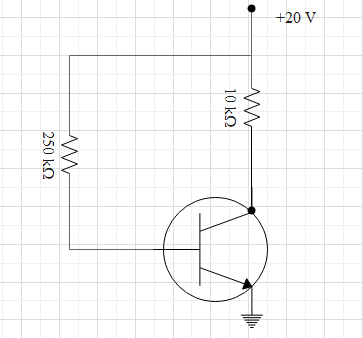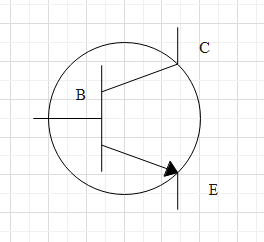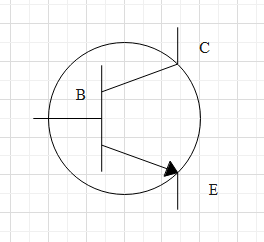
Identify the given transistor amplifier connection.

A. common base connection
B. common emitter connection
C. common collector connection
D. all of these

Answer
490.5k+ views
Hint-
The three electrical leads in a transistor are called the emitter, collector and the base. The following figure shows the positions of base, emitter and collector in the circuit symbol of a transistor.

Base is denoted as
Common Base configuration, is the configuration in which the base will be common between collector and emitter. That is, the base terminal will be common to the input signal and output signal.
Step by step solution:
A transistor is a three-terminal device. The three electrical leads in a transistor are called the emitter collector and the base. Analyze the following figure to identify the positions of base, emitter and collector in the circuit symbol of a transistor.

Base is denoted as
In common Base configuration, the base will be common between collector and emitter. The base terminal will then be common to the input signal and output signal that is why it is given the name common base.
In a common emitter configuration, the emitter will be common between collector and base. The emitter terminal will then be common to the input signal and outputs a signal that is why it is given the name common emitter.
In a common collector configuration, the collector will be common between emitter and base. The collector terminal will then be common to the input signal and output signal that is why it is given the name common collector.
From the circuit given in the question we can see that the base terminal is common to both collector and emitter. This means that the transistor is connected in common base configuration. The input current is current through the emitter,
Hence the correct answer is option A.
Note: Here, the arrow in the emitter terminal is directed outward which means it is an NPN transistor. If the arrow in the emitter terminal is directed inward then it will be a PNP transistor. Even if the transistor given in the circuit was a PNP transistor the configuration would be common base itself.
The three electrical leads in a transistor are called the emitter, collector and the base. The following figure shows the positions of base, emitter and collector in the circuit symbol of a transistor.

Base is denoted as
Common Base configuration, is the configuration in which the base will be common between collector and emitter. That is, the base terminal will be common to the input signal and output signal.
Step by step solution:
A transistor is a three-terminal device. The three electrical leads in a transistor are called the emitter collector and the base. Analyze the following figure to identify the positions of base, emitter and collector in the circuit symbol of a transistor.

Base is denoted as
In common Base configuration, the base will be common between collector and emitter. The base terminal will then be common to the input signal and output signal that is why it is given the name common base.
In a common emitter configuration, the emitter will be common between collector and base. The emitter terminal will then be common to the input signal and outputs a signal that is why it is given the name common emitter.
In a common collector configuration, the collector will be common between emitter and base. The collector terminal will then be common to the input signal and output signal that is why it is given the name common collector.
From the circuit given in the question we can see that the base terminal is common to both collector and emitter. This means that the transistor is connected in common base configuration. The input current is current through the emitter,
Hence the correct answer is option A.
Note: Here, the arrow in the emitter terminal is directed outward which means it is an NPN transistor. If the arrow in the emitter terminal is directed inward then it will be a PNP transistor. Even if the transistor given in the circuit was a PNP transistor the configuration would be common base itself.
Recently Updated Pages
Master Class 10 Science: Engaging Questions & Answers for Success

Master Class 10 Social Science: Engaging Questions & Answers for Success

Master Class 10 Maths: Engaging Questions & Answers for Success

Master Class 10 English: Engaging Questions & Answers for Success

Class 10 Question and Answer - Your Ultimate Solutions Guide

Master Class 9 General Knowledge: Engaging Questions & Answers for Success

Trending doubts
Give 10 examples of unisexual and bisexual flowers

Draw a labelled sketch of the human eye class 12 physics CBSE

Differentiate between homogeneous and heterogeneous class 12 chemistry CBSE

Differentiate between insitu conservation and exsitu class 12 biology CBSE

What are the major means of transport Explain each class 12 social science CBSE

What is the difference between resemblance and sem class 12 social science CBSE




